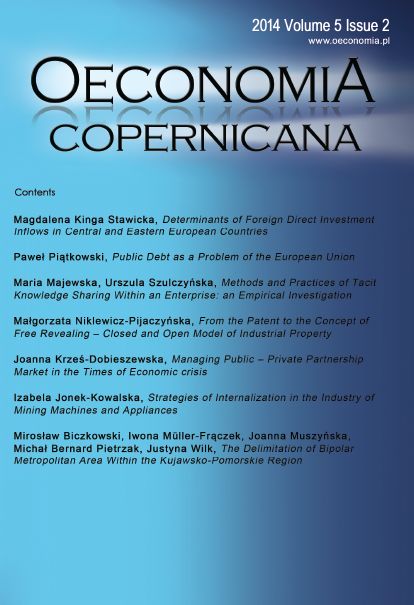From the Patent to the Concept of Free Revealing ? Closed and Open Model of Industrial Property
DOI:
https://doi.org/10.12775/OeC.2014.013Keywords:
patent, industrial property, free revealing, inventionsAbstract
This article is based on literature studies, comparative analysis of two different models to stimulate innovative solutions and protect industrial property rights ? particularly rights to inventions. For this purpose, the most important assumptions and the essence of traditional patent system based on institutional protection as well as concepts of free revealing (free access) and open innovation (open invention) were characterized. The paper also presents potential strengths and weaknesses of presented approaches ? closed (traditional) and open inventiveness. The article gives value to the argument that, given real shortcomings, the most effective way to create and commercialize inventions would be one of a complementary nature, taking into account solutions offered by each of the presented approaches, changing current innovation policy. On the one hand, modern companies should not give up institutional protection of their developed technology solutions and carrying out R&D, on the other, they will be increasingly forced to resort to modern tools of stimulating innovations based on openness, direct market communication and flexible approach to innovation processes of products and services.
Downloads
References
Colarelli O'Connor G., Corbett A., Pierantozzi R. (2010), Stwórz trzy odmienne ścieżki kariery dla innowatorów, ?Harvard Business Review Polska?, No. 11.
DeMonaco H.J. (2005), The major role of clinicians in the discovery of off label drug therapies, MIT Sloan Working Paper 4552-05. Referred after: Borek E., Otwarta innowacyjność na ratunek farmacji, www.qaly.pl/index.php/pl /publikacje/123-otwarta-innowacyjno-na-ratunek-farmacji.html.
Drucker P. (1895), Management, Tasks, Responsibilities, New York.
Harhoff D., Henkel J., von Hippel E. (2003), Profiting from voluntary information spillovers: How users benefit from freely revealing their innovations, Research Policy, Vol. 32, No.10, Referred after: Niedbalska G. (2011), Nowe podejście do problem własności intelektualnej, ?Economic Studies?, No. 2(LXIX).
Gajewski Ł. (2011), Zastosowanie koncepcji otwartej wynalazczości w procesach innowacyjnych [in:] Winiarski M. (ed.), Gospodarka: innowacje i rozwój, Prawnicza i Ekonomiczna Biblioteka Cyfrowa, Wrocław.
Gajewski Ł. (2009), Rynek wiedzy ? zewnętrzne źródło innowacyjnych pomysłów [in:] Winiarski M. (ed.), Nowe idee początku XXI wieku, Prawnicza i Ekonomiczna Biblioteka Cyfrowa, Wrocław.
Gault F., von Hippel E. (2009), User-Initiated Innovation in Canadian Manufacturing, ?NESTI?, June 3, Referred after: Niedbalska G. (2011), Nowe podejście do problem własności intelektualnej, ?Economic Studies?, Nr 2 ( LXIX ).
Iwanek M., Wilkin J. (1998), Instytucje i Instytucjonalizm w ekonomii, Wydawnictwo Uniwersytetu Warszawskiego, Warszawa.
Jasiński A.H. (2011), Aktywność patentowa a nakłady na badania i rozwój w okresie transformacji polskiej gospodarki [in:] Baczko T. (ed.), Raport o innowacyjności gospodarki Polski 2010 roku, INE PAN, Warszawa.
Kirzner I (2010), Konkurencja i przedsiębiorczość, Fijor, Warszawa
Lucas R.E. (1988), On the Mechanics of Economic Development, ?Journal of Monetary Economics?, Vol. 22.
Mattelart A. (2004), Społeczeństwo informacji, Universitas, Kraków.
Niedbalska G. (2009), Ekonomia free revealing. Nowe podejście do praw własności intelektualnej [in:] Baczko T. (ed.), Raport o innowacyjności gospodarki Polski w 2009 r., INE PAN, Warszawa 2010.
Niklewicz-Pijaczyńska M., Wachowska M. (2012), Wiedza-Kapitał ludzki-Innowacje, Prawnicza i Ekonomiczna Biblioteka Cyfrowa, Wrocław.
Romer P.M. (1990), Endogenous Technological Change, ?Journal of Political Economy?, Vol. 98.
Strategia egzekwowania praw własności intelektualnej w krajach trzecich, Dziennik Urzędowy Unii Europejskiej, (2005/C 129/03).
Schumpeter J. (1939), Business Cycles, McGraw-Hill, New York and London, http://dx.doi.org/10.1522/030021081.
Szczepanowska ? Kozłowska K. (1998), Patent europejski. Przedmiotowy zakres ochrony, KiK Konieczny i Kruszewski s.c., Warszawa.
Toffler A., Toffler H. (2006), Wojna i antywojna, Kurpisz S.A., Poznań.






